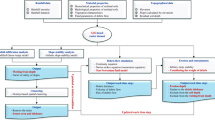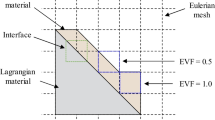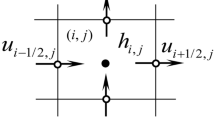Abstract
Debris flows are a type of fast landslides where a mixture of soil and water propagates along narrow channels. The main characteristics are (1) important relative displacements between the solid and fluid phases, and (2) development of pore-water pressures in excess to hydrostatic. The ratios between vertical and horizontal displacements of the flow, from the triggering point to the deposition, indicate that friction angles are much smaller than those measured in laboratories. Debris flows are modeled as two phases flow, but implementing pore-water pressure is an important issue. The purpose of this paper is to improve the existing two phases debris flow models by implementing pore-water pressures in excess to hydrostatic. It is found that pore pressure evolution depends on consolidation, changes in the flow depth, and changes and gradients of porosity. The proposed depth integrated mathematical model is discretized using two sets of SPH nodes (solid and fluid), with a set of finite difference meshes associated with each solid material SPH point. The paper presents two examples from where it is possible to gain insight into the differences between the models (with and without excess pore water pressure).



























Similar content being viewed by others
References
Andersen S, Andersen L (2010) Modelling of landslides with the material-point method. Comput Geosci 14(1):137–147
Anderson TB, Jackson R (1967) Fluid mechanical description of fluidized beds. Equations of motion. Ind Eng Chem Fundam 6(4):527–539
Ata R, Soulaïmani A (2005) A stabilized SPH method for inviscid shallow water flows. Int J Numer Methods Fluids 47(2):139–159
Belytschko T, Lu YY, Gu L (1994) Element-free Galerkin methods. Int J Numer Methods Eng 37(2):229–256
Benz W (1990) Smooth particle hydrodynamics: a review. In: Buchler JR (ed) Numerical modelling nonlinear stellar pulsations. Springer, Dordrecht, pp 269–288
Biot MA (1941) General theory of three-dimensional consolidation. J Appl Phys 12(2):155–164
Biot MA (1955) Theory of elasticity and consolidation for a porous anisotropic solid. J Appl Phys 26(2):182–185
Bonet J, Kulasegaram S, Rodriguez-Paz MX, Profit M (2004) Variational formulation for the smooth particle hydrodynamics (SPH) simulation of fluid and solid problems. Comput Methods Appl Mech Eng 193(12–14):1245–1256
Bui HH, Nguyen GD (2017) A coupled fluid-solid SPH approach to modelling flow through deformable porous media. Int J Solids Struct 125:244–264
Cascini L, Cuomo S, Pastor M, Rendina I (2016) SPH-FDM propagation and pore water pressure modelling for debris flows in flume tests. Eng Geol 213:74–83
Chen JK, Beraun JE, Carney TC (1999) A corrective smoothed particle method for boundary value problems in heat conduction. Int J Numer Methods Eng 46(2):231–252
Coetzee CJ, Vermeer PA, Basson AH (2005) The modelling of anchors using the material point method. Int J Numer Anal Methods Geomech 29(9):879–895
Córdoba G, Sheridan MF, Pitman EB (2015) TITAN2F: A pseudo-3-D model of 2-phase debris flows. Nat Hazards Earth Syst Sci Discuss 3(6):3789–3822
Duarte CA, Oden JT (1996) An h-p adaptive method using clouds. Comput Methods Appl Mech Eng 139(1–4):237–262
Gingold RA, Monaghan JJ (1977) Smoothed particle hydrodynamics—theory and application to non-spherical stars. Mon Not R Astron Soc 181:375–389
Gonda Y (2009) Function of a debris-flow brake. Int J Eros Control Eng 2(1):15–21
Gray JM, Wieland M, Hutter K (1999) Gravity-driven free surface flow of granular avalanches over complex basal topography. Proc R Soc Lond Ser A Math Phys Eng Sci 455(1985):1841–1874
Hutchinson JN (1986) A sliding-consolidation model for flow slides. Can Geotech J 23(2):115–126
Hutter K, Siegel M, Savage SB, Nohguchi Y (1993) Two-dimensional spreading of a granular avalanche down an inclined plane Part I. Theory. Acta Mech 100(1–2):37–68
Hutter K, Wang Y, Pudasaini SP (2005) The Savage–Hutter avalanche model: how far can it be pushed? Philos Trans R Soc A Math Phys Eng Sci 363(1832):1507–1528
Iverson RM (1997) The physics of debris flows. Rev Geophys 35(3):245–296
Iverson RM, Denlinger RP (2001) Flow of variably fluidized granular masses across three-dimensional terrain: 1. Coulomb mixture theory. J Geophys Res Solid Earth 106(B1):537–552
Jassim I, Stolle D, Vermeer P (2013) Two-phase dynamic analysis by material point method. Int J Numer Anal Methods Geomech 37(15):2502–2522
Laigle D, Coussot P (1997) Numerical modeling of mudflows. J Hydraul Eng 123(7):617–623
Li S, Liu WK (2004) Meshfree particle methods, 1st edn. Springer, Berlin
Liu GR, MB Liu (2003) Smoothed particle hydrodynamics: a meshfree particle method. World scientific, p 472. https://doi.org/10.1142/5340
Lucy LB (1977) A numerical approach to the testing of the fission hypothesis. Astron J 82:1013–1024
McDougall S, Hungr O (2004) A model for the analysis of rapid landslide motion across three-dimensional terrain. Can Geotech J 41(6):1084–1097
Melenk JM, Babuška I (1996) The partition of unity finite element method: basic theory and applications. Comput Methods Appl Mech Eng 139(1–4):289–314
Merodo JAF, Pastor M, Mira P, Tonni L, Herreros MI, Gonzalez E, Tamagnini R (2004) Modelling of diffuse failure mechanisms of catastrophic landslides. Comput Methods Appl Mech Eng 193(27–29):2911–2939
Monaghan JJ (1992) Smoothed particle hydrodynamics. Annu Rev Astron Astrophys 30(1):543–574
Monaghan JJ (2000) SPH without a tensile instability. J Comput Phys 159(2):290–311
Monaghan JJ, Gingold RA (1983) Shock simulation by the particle method SPH. J Comput Phys 52(2):374–389
Monaghan JJ, Kos A (1999) Solitary waves on a Cretan beach. J Waterw Port Coast Ocean Eng 125(3):145–155
Morris JP (1996) Analysis of smoothed particle hydrodynamics with applications. Ph.D. thesis, Monash University
Nayroles B, Touzot G, Villon P (1992) Generalizing the finite element method: diffuse approximation and diffuse elements. Comput Mech 10(5):307–318
Oñate E, Idelsohn S (1998) A mesh-free finite point method for advective-diffusive transport and fluid flow problems. Comput Mech 21(4–5):283–292
Pastor M, Blanc T, Pastor MJ (2009) A depth-integrated viscoplastic model for dilatant saturated cohesive-frictional fluidized mixtures: application to fast catastrophic landslides. J Nonnewton Fluid Mech 158(1–3):142–153
Pastor M, Blanc T, Haddad B, Drempetic V, Morles MS, Dutto P, Stickle MM, Mira P, Merodo JA (2015) Depth averaged models for fast landslide propagation: mathematical, rheological and numerical aspects. Arch Comput Methods Eng 22(1):67–104
Pastor M, Stickle MM, Dutto P, Mira P, Merodo JAF, Blanc T, Sancho S, Benítez AS (2015) A viscoplastic approach to the behaviour of fluidized geomaterials with application to fast landslides. Contin Mech Thermodyn 27(1–2):21–47
Pastor M, Yague A, Stickle MM, Manzanal D, Mira P (2018) A two-phase SPH model for debris flow propagation. Int J Numer Anal Methods Geomech 42(3):418–448
Pastor M, Quecedo M, Merodo JA, Herrores MI, Gonzalez E, Mira P (2002) Modelling tailings dams and mine waste dumps failures. Géotechnique 52(8):579–591
Pastor M, Blanc T, Pastor MJ, Sánchez M, Haddad B, Mira P, Fernández-Merodo JA, Herreros I, Drempetic V (2007) A SPH depth integrated model with pore pressure coupling for fast landslides and related phenomena. In: Ho & Li (eds) 2007 International forum on landslide disaster management. Hong Kong, pp 987–1014
Pastor M, Quecedo M, Gonzalez E, Herreros MI, Merodo JA, Mira P (2004) Modelling of landslides: (II) propagation. In: Felix D, Ioannis V (eds) Degrad. Instab. Geomaterials, pp 319–367. Springer, Vienna
Pitman EB, Le L (2005) A two-fluid model for avalanche and debris flows. Philos Trans R Soc A Math Phys Eng Sci 363(1832):1573–1601
Pudasaini SP (2012) A general two-phase debris flow model. J Geophys Res Earth Surf 117(F3):F03010
Pudasaini SP, Hutter K (2007) Avalanche dynamics: dynamics of rapid flows of dense granular avalanches. Springer, Berlin
Quecedo M, Pastor M, Herreros MI (2004) Numerical modelling of impulse wave generated by fast landslides. Int J Numer Methods Eng 59(12):1633–1656
Randles PW, Libersky LD (2000) Normalized SPH with stress points. Int J Numer Methods Eng 48(10):1445–1462
Rodriguez-Paz M, Bonet J (2005) A corrected smooth particle hydrodynamics formulation of the shallow-water equations. Comput Struct 83(17–18):1396–1410
Saint-Venant A (1871) Theorie du mouvement non permanent des eaux, avec application aux crues des rivieres et a l’introduction de marees dans leurs lits. Comptes-Rendus l’Académie Des Sci 73:147–273
Salazar F, Oñate E, Morán R (2011) Numerical modeling of landslides in reservoirs using the Particle Finite Element Method (PFEM). pp 245–250, Valencia, Spain. Risk Analysis, Dam Safety, Dam Security and Critical Infrastructure Management: Proceedings of the 3rd International Forum on Risk Analysis. Dam Safety, Dam
Savage SB, Hutter K (1989) The motion of a finite mass of granular material down a rough incline. J Fluid Mech 199:177–215
Savage SB, Hutter K (1991) The dynamics of avalanches of granular materials from initiation to runout. Part I: analysis. Acta Mech 86(1–4):201–223
Vacondio R, Rogers BD, Stansby PK, Mignosa P, Feldman J (2013) Variable resolution for SPH: a dynamic particle coalescing and splitting scheme. Comput Methods Appl Mech Eng 256:132–148
Vacondio R, Mignosa P, Pagani S (2013) 3D SPH numerical simulation of the wave generated by the Vajont rockslide. Adv Water Resour 59:146–156
Vacondio R, Rogers BD, Stansby PK, Mignosa P (2013) Shallow water SPH for flooding with dynamic particle coalescing and splitting. Adv Water Resour 58:10–23
Wang Y, Hutter K (1999) A constitutive theory of fluid-saturated granular materials and its application in gravitational flows. Rheol Acta 38(3):214–223
Wiȩckowski Z (2004) The material point method in large strain engineering problems. Comput Methods Appl Mech Eng 193(39–41):4417–4438
Wilson FM (2005) Report on the debris flow at Sham Tseng San Tsuen of 23 august 1999. Technical report, Findings of the investigation. GEO REPORT No. 169, Geotechnical Engineering Office, Civil Engineering and Development Department, The Government of the Hong Kong Special Administrative Region
Xia X, Liang Q, Pastor M, Zou W, Zhuang Y (2013) Balancing the source terms in a SPH model for solving the shallow water equations. Adv Water Resour 59:25–38
Yifru AL, Laache E, Norem H, Nordal S, Thakur VK (2018) Laboratory investigation of performance of a screen type debris-flow countermeasure. HKIE Trans 25(2):129–144
Zabala F, Alonso EE (2011) Progressive failure of Aznalcóllar dam using the material point method. Géotechnique 61(9):795–808
Zhu Y, Fox PJ (2001) Smoothed particle hydrodynamics model for diffusion through porous media. Transp Porous Media 43(3):441–471
Zienkiewicz OC, Chan AHC, Pastor M, Shrefler BA, Shiomi T (1999) Computational geomechanics with special reference to earthquake engineering. Wiley, p 398
Zienkiewicz OC, Shiomi T (1984) Dynamic behaviour of saturated porous media; the generalized Biot formulation and its numerical solution. Int J Numer Anal Methods Geomech 8(1):71–96
Zienkiewicz OC, Xie YM, Schrefler BA, Ledesma A, Bicanic N (1990) Static and dynamic behaviour of soils: a rational approach to quantitative solutions. II. Semi-saturated problems. Proc R Soc A Math Phys Eng Sci 429(1877):311–321
Acknowledgements
The authors gratefully acknowledge the economic support provided by the Spanish Ministry MINECO under project ALAS (BIA2016-76253-P). In addition, the authors gratefully acknowledge the support of the Geotechnical Engineering Office, Civil Engineering and Development Department of the Government of the Hong Kong SAR in the provision of the digital terrain models for the Hong Kong landslide case.
Author information
Authors and Affiliations
Corresponding author
Additional information
Publisher's Note
Springer Nature remains neutral with regard to jurisdictional claims in published maps and institutional affiliations.
Rights and permissions
About this article
Cite this article
Pastor, M., Tayyebi, S.M., Stickle, M.M. et al. A depth integrated, coupled, two-phase model for debris flow propagation. Acta Geotech. 16, 2409–2433 (2021). https://doi.org/10.1007/s11440-020-01114-4
Received:
Accepted:
Published:
Issue Date:
DOI: https://doi.org/10.1007/s11440-020-01114-4




